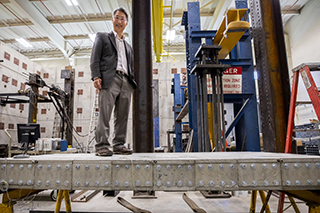RECOBLOX™
Construction with Zero Waste
A modular approach to building, inspired by Lego toys, reduces waste across the life-cycle of a structure, from its design to its destruction.
Waste is an unfortunate reality of our current construction approach, from the energy and materials used for mixing and casting to the post-demolition debris that ends up in landfills. Combining ECC with innovations in 3D printing and digital technologies make possible transformations in construction unimaginable even a decade ago. “You can actually change the material composition, almost at the scale of a square inch, to suit structural demands and performance,” says Wes McGee, director of the University of Michigan Digital Fabrication Lab and an Associate Professor at Taubman College of Architecture and Urban Planning.
RecoBlox™ represent a new approach to construction: Centered around reconfigurable construction blocks they that utilizes automation, digitization, and robotics with a goal of complete material reuse.
These smart, rapidly joinable bricks are 3D printed to order, carbon cured, tagged, and inventoried in distributed warehouses. Based on information from digitized architectural or structural designs, they can be selectively retrieved, transported to construction sites, and assembled into structures using computer vision–aided robots.
When a structure is no longer needed, it can be disassembled, with the RecoBlox™ reconfigured into a different structure or returned to inventory. If embedded sensors in the bricks detect deterioration, the damaged components will be rerouted to a factory for refurbishing with carbon dioxide before being inventoried.
The new paradigm for construction represented by RecoBlox™ will require novel financial, logistical, and legal approaches. That is why the development team includes leadership from the University of Michigan Schools of Business, Public Policy, and Architecture and Urban Planning
“As a designer, I am trying to manage the material, and I’m trying to manage the process,” says Tsz Yan Ng, Assistant Professor of Architecture. “There are all kind of benefits—not just for the final outcome but also the industry, from cement manufacturers to contractors to construction workers, in a safer, more controlled factory setting.”

“Concrete innovation is not just the function of shaping concrete but what concrete building can potentially offer.”
